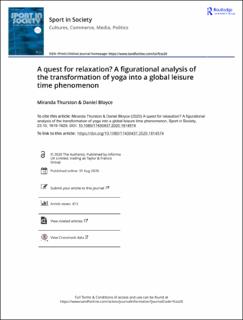A quest for relaxation? A figurational analysis of the transformation of yoga into a global leisure time phenomenon
Peer reviewed, Journal article
Published version
Permanent lenke
https://hdl.handle.net/11250/2732052Utgivelsesdato
2020Metadata
Vis full innførselSamlinger
Sammendrag
Eric Dunning and Norbert Elias began developing their concept ‘quest for excitement’ in the 1960s. In this paper we consider the concept in the context of their work on the civilizing process and leisure in the spare-time spectrum, applying it to an analysis of the global diffusion and transformation of yoga. In so doing, we develop a preliminary theoretical account of its global popularity as a leisure-time movement form. We specifically consider the extent to which yoga’s transformation from the late 19th century onwards can be understood as a socially generated psychological quest for excitement rather than as a need for relaxation. We take a long-term developmental perspective, focusing on processes of globalization to explain the transformation of yoga into an increasing variety of forms. We argue that its global popularity is linked to its transformation into a diversity of styles, which provide flexible, individualized, non-competitive and health-oriented leisure opportunities that have become attractive to an increasing number of people. We conclude that the contouring of yoga in this way reflects the socially generated leisure time needs of people in complex societies. Our preliminary theoretical account, informed by the work of Dunning and colleagues, illuminates how yoga, as a polymorphous social practice, provides leisure enclaves which can lead to an upsurge of satisfying emotions and hence can be psychologically restorative.

